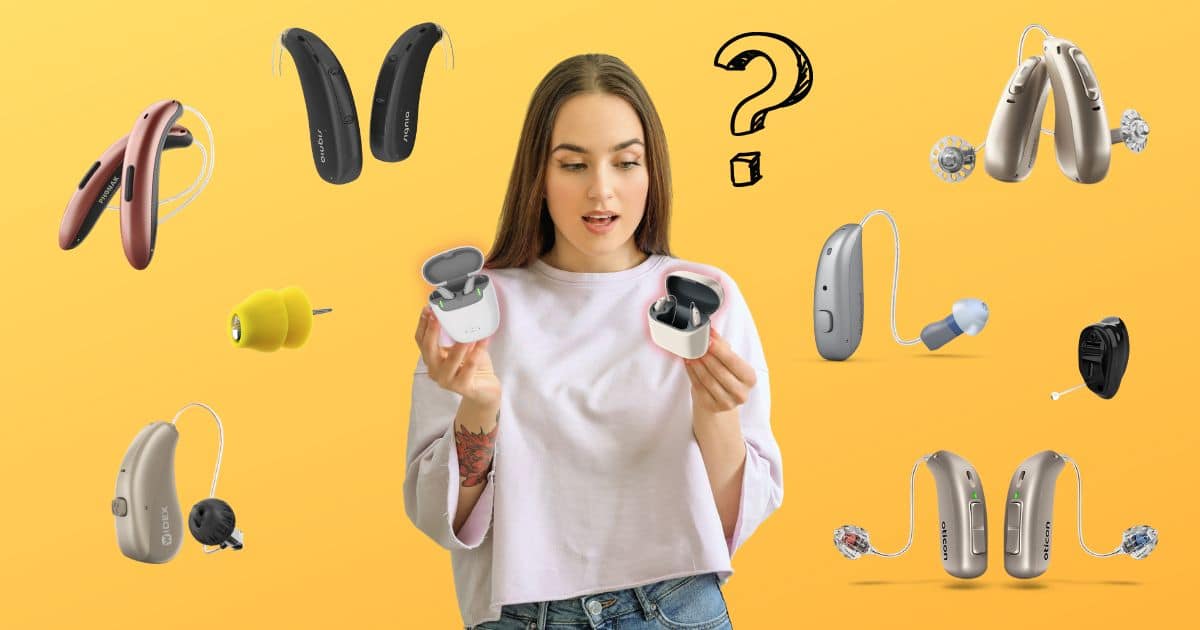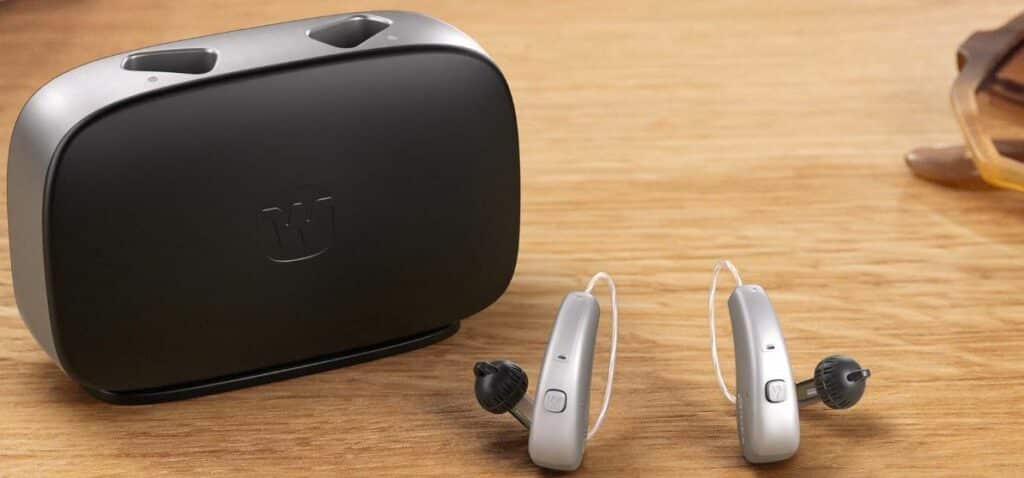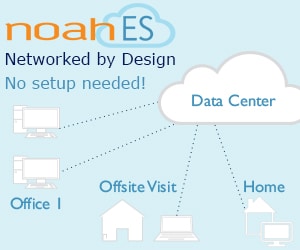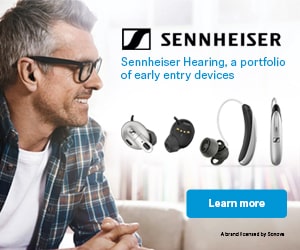Navigating the diverse landscape of available hearing aids, each boasting various promises, can be a challenging task. The multitude of factors to consider when choosing a suitable hearing aid requires a comprehensive approach, typically initiated by a consultation with a hearing care practitioner (HCP). This consultation investigates the potential causes of hearing loss, medical history, lifestyle considerations, and the functional difficulties experienced due to their hearing loss.
Subsequent to the case history analysis, individuals undergo a series of tests to assess the degree and configuration of their hearing loss. Speech in noise tests are also frequently conducted by the HCP to gauge the challenges faced in noisy environments and determine the potential benefits of hearing aids.
It is crucial to emphasize that in the field of prescription hearing aids, the testing process coupled with the expertise of an HCP provides a holistic approach. This approach integrates the potential detection of underlying medical conditions, appropriate referrals, and advanced measures to ensure that the prescribed hearing aid settings are based on precise measurements, utilizing advanced algorithms for optimal levels of amplification and comfort.

A professional can provide you with a comprehensive look at your hearing status and help guide you on the best type of device to suit your individual needs
Moreover, hearing loss is a deeply personal experience. Traditional prescription fitting not only addresses the technical aspects but also offers patients comprehensive counseling, support, and aural rehabilitation when the prescribed guidelines are diligently followed.
In this article, we look into the most coveted attributes of hearing aids, considering both user preferences and professional perspectives to identify the top prescription hearing aids for the current year. Understanding what users and hearing care professionals prioritize provides valuable insights into the qualities that define the best hearing aids.
Hearing Aid Features Most Desired by Users
User-desired features play a crucial role in shaping the perspectives of individuals using hearing aids. Addressing these desired features enhances the likelihood that users will fully embrace and positively perceive their hearing aids, fostering a more favorable attitude towards adopting and consistently using these devices.
Key Patient-Desired Features Include:
- Rechargeability
- Hearing speech in noise
- Appearance
- Price considerations (Budget or medical insurance)
- Bluetooth and streaming capabilities
- Tinnitus relief
- App-based control
- Remote support options
- Physical comfort
- Noise reduction
Similarly, hearing professionals are guided by desired features in their choices when recommending hearing aids. Their preferences are influenced by experiences with specific hearing aids and the attributes that contribute to a successful fit, ensuring satisfied clients.
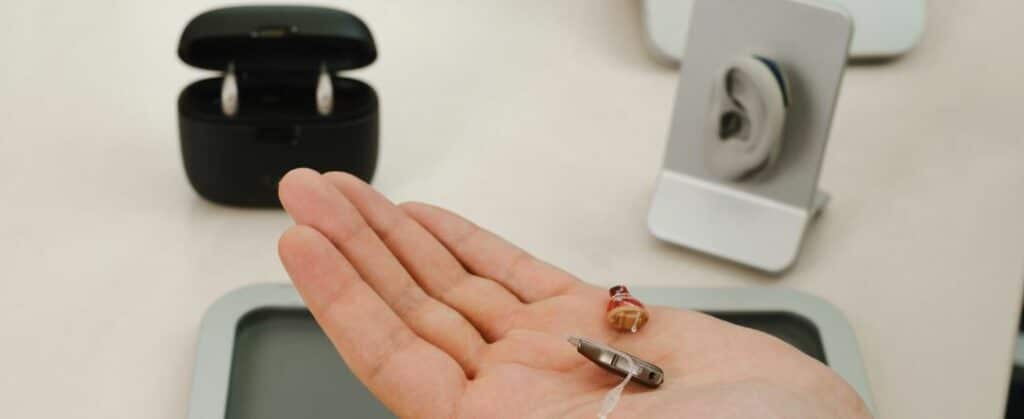
Essential Features Recommended by Professionals:
- Feedback management
- User-friendly programming interface
- Evidence-based support for hearing aid functionality
- Directional microphones
- Noise reduction
- Manufacturer support
While this is certainly not an exhaustive list, most professionals would agree that the essentials will be an excellent starting point and are often standard features available on most of today’s modern prescription hearing aids.
A Quick Look at the Best Hearing Aids
- Future-Proof Connectivity: ReSound Nexia
- First Waterproof Rechargeable: Phonak Audeo Lumity Life
- Best for tinnitus and processing speed: Widex Moment Sheer
- Advanced Features and Balanced Sound: Oticon Real
- Most Discreet Hearing Aids: Phonak Lyric
- Comprehensive Tech for All Ages: Starkey Genesis AI
- Enhanced Sound Processing: Signia Pure Charge&Go IX
- Ultimate Power and Battery Life: Signia Motion SP X Charge&Go
- Hearing Tech with Style: Phonak Slim
ReSound Nexia Hearing Aids – Future Proof Connectivity
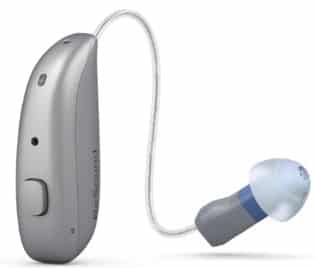 The ReSound Nexia is the latest solution from GN Hearing, which replaced the company’s popular Omnia devices. The Nexia range introduces two non-rechargeable RIE (Receiver-In-Ear) models and a compact rechargeable microRIE. The microRIE stands out as the smallest and most comfortable style, boasting advanced technology.
The ReSound Nexia is the latest solution from GN Hearing, which replaced the company’s popular Omnia devices. The Nexia range introduces two non-rechargeable RIE (Receiver-In-Ear) models and a compact rechargeable microRIE. The microRIE stands out as the smallest and most comfortable style, boasting advanced technology.
Additionally, ReSound Nexia seamlessly connects with Auracast™ broadcast audio, offering an exciting advancement in connectivity for individuals with hearing loss.
Key Features:
- Smallest Rechargeable RIE: The microRIE is 25% smaller than the standard RIE, prioritizing comfort, microphone performance, and convenience. It includes features like an accelerometer for answering calls with a double tap and a wireless CROS/BiCROS system for individuals with single-sided deafness.
- Improved Speech Understanding in Noise: Addressing common pain points for hearing aid users, ReSound Nexia focuses on enhancing speech understanding in noisy environments, providing industry-leading access to surrounding sounds.
- ReSound’s M&RIE system combines traditional hearing aid mics with an in-ear mic for natural sound capture, addressing limitations in RIC and BTE aids. It is said to enhance sound localization by 9% to 10%, benefiting those with mild hearing loss. Suitability depends on ear canal size, with potential feedback issues in smaller canals. Hearing care providers assess compatibility.
- Binaural Beamformer and Omni-Directional Listening: The combination of a 4-microphone binaural beamformer and omni-directional listening allows users to automatically hear speech from all directions.
- Bluetooth® LE Audio: ReSound Nexia features Bluetooth® LE Audio, the new connectivity standard, offering multiple simultaneous connections, hands-free calls with compatible devices, and improved sound quality with lower battery consumption.
- Compatibility with Auracast™ Broadcast Audio: A standout feature, ReSound Nexia is compatible with Auracast™ broadcast audio, transforming the hearing aid experience by delivering important announcements and facilitating audio streaming in private and public spaces.
Limitations:
- Only 3 technology levels offered, so may be out of reach for some budgets
- No custom in-ear models or BTE options for Nexia platform
Average pricing ranges from $3500-$8000/pair for professionally fit devices, depending upon performance level chosen and clinic service offering provided. The ReSound premium technology typically includes 3 year repair warranty and 3 year loss/damage insurance.
Phonak Audeo Lumity Hearing Aids – First Waterproof Rechargeable
 The Phonak Audeo Lumity line introduces three exclusively rechargeable models, namely Phonak Lumity R, Phonak Lumity RT, and Phonak Lumity R-Life. These models are available in four different tiers—Lumity 90, Lumity 70, Lumity 50, and Lumity 30—each offering varying levels of technology and customization.
The Phonak Audeo Lumity line introduces three exclusively rechargeable models, namely Phonak Lumity R, Phonak Lumity RT, and Phonak Lumity R-Life. These models are available in four different tiers—Lumity 90, Lumity 70, Lumity 50, and Lumity 30—each offering varying levels of technology and customization.
Notably, the higher tiers provide access to advanced features, while the Lumity Life stands out with extensive waterproofing for added durability.
Key Features:
- Bluetooth Capability: The Phonak Lumity line supports universal Bluetooth connectivity for both iPhone and Android devices, allowing pairing with up to eight devices for versatile streaming options.
- Motion Sensor Hearing: Lumity hearing aids incorporate motion sensors for adaptive microphone configuration, enabling features like tap control for hands-free operation.
- Rechargeability: Powered by lithium-ion rechargeable batteries, Lumity R, Lumity RT, and Lumity R-Life offer all-day battery life, with a quick 15-minute charge providing an additional three hours. The upgraded Phonak Charger Ease enhances ease of use.
- AutoSense 5.0 Operating System: Lumity features the latest Phonak AutoSense operating system, utilizing artificial intelligence for automatic adaptation to diverse listening environments, including streaming programs.
- SpeechSensor and StereoZoom 2.0: Exclusive to Lumity 90, SpeechSensor enhances speech understanding from sides and behind, while StereoZoom 2.0 focuses on speech in front, improving clarity and reducing listening effort.
- Dynamic Noise Cancellation and Speech Enhancer: Lumity offers Dynamic Noise Cancellation in both 70 and 90 tier levels, while Speech Enhancer, amplifying soft talkers, is exclusive to Lumity 90.
- Accessories: Lumity is compatible with ActiveVent receivers, integrated Roger receivers for connecting with Phonak Roger devices, and various accessories, including the Phonak TV connector, PartnerMic, and the updated MyPhonak app.
Highlights
- Extensive Bluetooth capability for versatile audio streaming.
- Motion sensor hearing for hands-free operation and tap control.
- Advanced AutoSense 5.0 operating system with over 200 customizable settings.
- Exclusive features like SpeechSensor, StereoZoom 2.0, and Speech Enhancer in Lumity 90.
- Compatibility with a range of accessories, including ActiveVent receivers and integrated Roger receivers.
Widex Moment Sheer – Ultra Fast Processing and Tinnitus Options
 Widex Moment Sheer represents the company’s latest advancement in hearing technology, building on the successes of the company’s prior Moment series hearing aids.
Widex Moment Sheer represents the company’s latest advancement in hearing technology, building on the successes of the company’s prior Moment series hearing aids.
The award-winning hearing aids are known for their unique sound therapy feature and ultra-fast sound processing. Featuring ZeroDelay technology for minimal signal delay, these devices offer a natural sound experience and compatibility with remote care. The MOMENT mini–Receiver in Canal (RIC) boasts being the smallest rechargeable lithium-ion RIC on the market, providing improved moisture protection.
The devices boast several cutting-edge features, including:
-
MySound 2.0: An AI-based customization tool offering personalized sound experiences through compression settings and customizable parameters.
-
Widex SoundRelax: An extensive library of fractal sounds designed for calming effects, customizable through the Widex MOMENT app, catering to wearers with and without tinnitus.
-
Widex Sound Assist: A versatile device offering partner and table microphone functionality, hands-free phone calls, Bluetooth streaming, and remote control of Widex Moment Sheer hearing aids.
-
Modern Design: Elevated aesthetics in product, packaging, and accessories ensure a harmonious blend of exceptional technology and design.
-
Widex PureSound with ZeroDelay: Maintains the fastest sound processing, preserving natural sound by retaining spatial cues for a more layered auditory experience.
-
TruAcoustics™ and Instant Ear-tips: A new range of instant ear-tips, coupled with TruAcoustics™ fitting calculation software, ensures better acoustical stability and accommodates a broader range of hearing losses fitted with instant tips, providing hearing care professionals greater flexibility.
Key Features:
Receiver in Canal (RIC) Style
- Ideal for mild to severe hearing loss.
- Available in 4 technology levels: 440, 330, 220, 110.
- Rechargeable with 29 hours of battery life.
- Allows streaming of phone calls, music, and podcasts from Android or Apple devices.
- Comfortably sits behind the ear with buttons or an app for volume changes.
Limitations:
- Recharging case is less portable than some competitors
- Remote/telehealth functionality only available with Widex RemoteLink accessory
Average pricing ranges from $3500-$8000/pair for professionally fit devices, depending upon performance level chosen and clinic service offering provided. The Widex premium technology typically includes 3 year repair warranty and 3 year loss/damage insurance.
Oticon Real Hearing Aids – Advanced Features and Balanced Sound
 The Oticon Real hearing aid is the latest and most advanced addition to Oticon’s lineup, offering a versatile array of features to address diverse user needs. Anchored by a deep neural network (DNN) and machine-learning algorithms, the Real series ensures heightened sound input to the brain.
The Oticon Real hearing aid is the latest and most advanced addition to Oticon’s lineup, offering a versatile array of features to address diverse user needs. Anchored by a deep neural network (DNN) and machine-learning algorithms, the Real series ensures heightened sound input to the brain.
Utilizing BrainHearing™ technology, it incorporates advanced features like OpenSound Navigator and OpenSound, complemented by tinnitus functions for added convenience. The wind and noise cancellation feature, along with Bluetooth connectivity enabling direct streaming from iPhone and select Android smartphones, helps elevate the overall user experience.
Key Features:
- Deep neural network and machine-learning algorithms.
- BrainHearing technology with advanced features like OpenSound Navigator and OpenSound.
- Tinnitus functions for added convenience.
- Wind and noise cancellation feature.
- Bluetooth connectivity for direct streaming from smartphones.
Additional Features:
- Polaris R microchip for improved technical function.
- MoreSound Intelligence for distinguishing different listening situations.
- MoreSound Amplifier 2.0 for balanced, high-contrast hearing.
- SuddenSound Stabilizer for controlling sudden sounds.
Limitations:
- More premium price point, even for entry-level devices.
- Potential for a more complicated technology operation compared to competitors.
Average pricing ranges from $4000-$8000/pair for professionally fit devices, depending upon performance level chosen and clinic service offering. Oticon’s premium technology typically includes 3 year repair warranty and 3 year loss/damage insurance.
Lyric Hearing Aids – Ultimate in Discretion
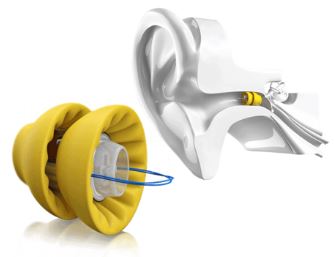 Lyric hearing aids stand out as a distinctively unique solution. Unlike traditional hearing aids that are removed daily, Lyric remains in the ear canal 24/7 for approximately two months, allowing wearers to shower and sleep without removal. After this period, an audiologist replaces them with two new devices.
Lyric hearing aids stand out as a distinctively unique solution. Unlike traditional hearing aids that are removed daily, Lyric remains in the ear canal 24/7 for approximately two months, allowing wearers to shower and sleep without removal. After this period, an audiologist replaces them with two new devices.
In contrast to typical hearing aids used for 4-6 years, Lyric operates on an annual subscription model. This subscription covers both the devices and services for a 12-month period, with the option to renew at the end. While Lyric hearing aids are comparatively expensive, their unparalleled ease of use and sound quality, free from the bass-heavy occlusion effect, contribute to high satisfaction among users.
Despite lacking advanced features like Bluetooth streaming or an app, Lyric excels in invisibility, convenience, and clear sound quality. Lyric’s key features include deep, invisible placement, 24/7 wear without removal, professional insertion and replacement every 4-6 weeks, and subscription-type pricing averaging around $4,000 per year.
Why Lyric Stands Out:
- Invisibility, offering the most discreet appearance.
- Unmatched convenience with no need for removal, cleaning, battery changes, or charging.
- Suitable for mild to moderately severe hearing loss.
- Natural sound quality with analog processing.
- Provides relief for tinnitus.
- Quick placement times.
- Water-resistant, allowing showering with the device.
- Accommodates a wide range of ear canal sizes.
- Allows for activities like wearing helmets, playing sports, and using external headphones or some earbuds.
- Enables phone calls by placing it on your ear.
Considerations and Limitations:
- Requires professional assistance for insertion and replacement.
- Involves more frequent professional visits.
- Suitable for mild to moderate hearing loss.
- Annual subscription cost.
- Limited user-adjustable settings.
- Lacks Bluetooth technology due to its small size.
- Not waterproof (no swimming).
- Must be removed for MRIs due to metal parts.
- Higher cost.
Starkey Genesis AI Hearing Aids – Comprehensive Tech for All Ages
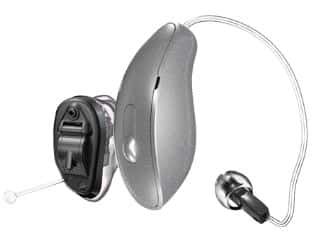 Starkey’s Genesis AI technology stands out as the industry’s most advanced processor technology, incorporating a rechargeable battery that provides an impressive 51 hours of usage on a single charge. Notably, it boasts the smallest rechargeable receiver-in-canal (RIC) with a sensor. Additionally, a new 2.4 GHz completely-in-canal (CIC) hearing aid, powered by the Starkey Neuro Processor and Neuro Sound Technology, has been introduced to the lineup.
Starkey’s Genesis AI technology stands out as the industry’s most advanced processor technology, incorporating a rechargeable battery that provides an impressive 51 hours of usage on a single charge. Notably, it boasts the smallest rechargeable receiver-in-canal (RIC) with a sensor. Additionally, a new 2.4 GHz completely-in-canal (CIC) hearing aid, powered by the Starkey Neuro Processor and Neuro Sound Technology, has been introduced to the lineup.
The Genesis AI hearing aid series includes a redesigned standard case, enhancing user convenience and featuring a 25% increase in battery life. The Neuro Processor, equipped with increased speed and transistors, mirrors the function of the central auditory system. It incorporates improvements to Edge Mode+ and introduces various professional and patient updates. Noteworthy features encompass multiflex tinnitus technology sound therapy accessible through the app.
Key Features:
- Advanced features including fall detection and noise reduction.
- Artificial intelligence for enhanced functionality.
- Industry-leading processor technology – Starkey Neuro Processor.
- Deep Neural Network (DNN) accelerator engine for detailed sound perception.
- Up to 51 hours of battery life per charge.
Additional Features:
- Bluetooth connectivity for streaming and hands-free calling.
- Variety of form factors, including Receiver-in-Canal (RIC) and custom In-the-Ear (ITE) models.
- Compatible with Starkey’s wireless accessories.
Limitations:
- More premium price point, even for entry-level devices.
- Not yet offered in a behind-the-ear (BTE) model.
Average pricing ranges from $3500-$8000+/pair for professionally fit devices, depending upon style and performance level chosen and clinic service offering. Starkey’s premium technology typically includes 3 year repair warranty and 3 year loss/damage insurance.
Signia Pure Charge&Go IX Hearing Aids – Enhanced Sound Processing
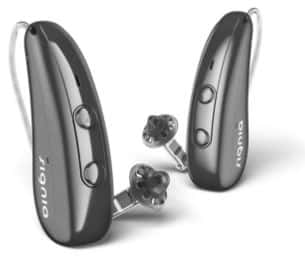 At the end of 2023, Signia launched the Pure Charge&Go IX, their latest receiver-in-canal (RIC) hearing aid. Compact and lightweight, it features advanced technology such as Bluetooth streaming, a telecoil option, lithium-ion batteries, and Signia’s latest sound processing.
At the end of 2023, Signia launched the Pure Charge&Go IX, their latest receiver-in-canal (RIC) hearing aid. Compact and lightweight, it features advanced technology such as Bluetooth streaming, a telecoil option, lithium-ion batteries, and Signia’s latest sound processing.
The battery life is impressive, providing up to 39 hours of use per charge in telecoil equipped model. The redesigned rocker switch button enhances tactile functionality. The Pure Charge&Go IX showcases improvements in sound quality, connectivity, and battery life, supporting direct streaming from both iPhone and Android devices and future Bluetooth LE Audio standard compatibility.
Key Features:
- Compact and lightweight RIC design.
- Bluetooth streaming and telecoil option.
- Lithium-ion batteries for up to 39 hours of use per charge.
- Programmable rocker switch for volume adjustment and program switching.
- Signia smartphone app for additional customization and wireless connectivity.
- RealTime Conversation Enhancement technology for clear and detailed conversations.
- Own Voice Processing 2.0 for natural-sounding voice.
- AI-powered Signia Assistant for on-the-fly adjustments.
- Compatibility with upcoming Bluetooth LE Audio standard.
- Current support for Made-for-iPhone (MFi) and ASHA direct streaming.
Limitations
- Currently available in 3 technology levels: 3IX, 5IX, 7IX. No budget line available yet
Average pricing ranges from $3500-$8000/pair for professionally fit devices, depending upon performance level chosen and clinic service offering. Signia’s premium technology typically includes 3 year repair warranty and 3 year loss/damage insurance.
Signia Motion Charge&Go SP X – Ultimate Power and Battery Life
 The Motion Charge&Go SP X stands as the industry’s first rechargeable super power hearing aid, targeting individuals with severe to profound hearing loss. Its standout feature is an unprecedented 61 hours of run-time per charge, making it the most powerful rechargeable hearing aid globally. Equipped with acoustic-motion sensors, Own Voice Processing (OVP™), and compatibility with the Signia Xperience platform, these devices offer personalized and precise hearing experiences.
The Motion Charge&Go SP X stands as the industry’s first rechargeable super power hearing aid, targeting individuals with severe to profound hearing loss. Its standout feature is an unprecedented 61 hours of run-time per charge, making it the most powerful rechargeable hearing aid globally. Equipped with acoustic-motion sensors, Own Voice Processing (OVP™), and compatibility with the Signia Xperience platform, these devices offer personalized and precise hearing experiences.
Noteworthy features include Made for iPhone direct streaming, the Signia App for controls and remote care, Li-ion charging, Bluetooth® connectivity, and telecoil support. The Motion Charge&Go SP X series is available across a wide range of performance levels, with an upgrade option that includes a UV Dry&Clean charger. Average pricing ranges from $2000-$7000/pair for professionally fit devices, depending upon performance level chosen
Key Features:
- Up to 61 hours of run-time per charge.
- Own Voice Processing (OVP™) for enhanced voice clarity.
- Made for iPhone direct streaming capability.
- Signia App for controls, streaming, tinnitus therapy, and remote care support.
- Li-ion charging for convenience and sustainability.
- Bluetooth® connectivity for seamless device integration.
- Telecoil support for improved hearing in specific environments.
- Acoustic-motion sensors for adaptive hearing experiences.
- Available across various performance levels to suit individual needs and budgets
- Option to upgrade to include a UV Dry&Clean charger.
Limitations:
- No disposable battery option offered for those that want them
- Based on the Xperience platform, not yet available on current IX platform
Average pricing ranges from $2000-$8000/pair for professionally fit devices, depending upon performance level chosen and clinic service offering. Signia’s premium technology typically includes 3 year repair warranty and 3 year loss/damage insurance.
Phonak Slim – Hearing Tech with Style
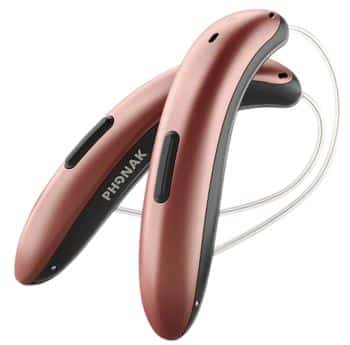 In 2023, Phonak announced the launch of the Phonak Slim, a groundbreaking hearing aid that seamlessly merges sophisticated technology with a sleek, fashion-forward design. Beyond its stylish appearance (similar in design to the Signia Styletto), the Phonak Slim stands out as a high-performance device, designed to enhance the hearing experience for users.
In 2023, Phonak announced the launch of the Phonak Slim, a groundbreaking hearing aid that seamlessly merges sophisticated technology with a sleek, fashion-forward design. Beyond its stylish appearance (similar in design to the Signia Styletto), the Phonak Slim stands out as a high-performance device, designed to enhance the hearing experience for users.
Its unique form factor follows the natural curvature of the ear, breaking away from the traditional bulkiness associated with hearing aids, while offering an array of colors for personalization. Average pricing ranges from $4000-$8000/pair for professionally fit devices, depending upon performance level chosen and clinic service offering.
Key Features:
- Fashion-forward Design: Distinctive and ergonomic design with a 7-degree bend, providing a snug fit while aiming to break down the stigma of wearing hearing aids.
- Color Varieties: Available in four two-tone color combinations, including Graphite/Black, Copper/Black, Sandalwood/Black, and Silver/Black, allowing users to match their personal style.
- Latest Technology: Runs on the same platform as Phonak’s flagship product, the Audeo Lumity
- AutoSense OS 5.0: Automatic operating system employing machine learning to scan the environment 700 times per second for real-time adjustments, ensuring a seamless listening experience.
- SmartSpeech Technology: Incorporates StereoZoom 2.0 and SpeechSensor for enhanced background noise management and better speech understanding.
- Advanced Connectivity: Features tap-control, hands-free calling for Android and iPhone devices, and stable Bluetooth classic connection for easy control of hearing aid settings and seamless audio experiences.
- myPhonak App Compatibility: Pairs with the myPhonak app, offering personalized hearing experiences, health data tracking, and remote control functionality for adjusting settings.
Limitations:
- Limited availability in the 90 and 70 technology levels only, excluding the more affordable 50 and 30 technology levels.
- Longer than traditional hearing aid and no telecoil available
Average pricing ranges from $4000-$8000/pair for professionally fit devices, depending upon performance level chosen and clinic service offering. Phonak’s premium technology typically includes 3 year repair warranty and 3 year loss/damage insurance.
Insurance Benefits
While this article has primarily discussed the top hearing aids and their features, insurance benefits will often play a significant role in the decision-making process. While Medicare itself unfortunately doesn’t cover hearing aids, many Medicare Advantage plans have hearing benefits, as do a number of different commercial, private insurance plans.
These benefits can potentially reduce the price of hearing aids by 25%, 50%, or even cover the entire cost in some cases. It is advisable to explore your insurance benefits before making a purchase and have a discussion with your HCP as to how using the benefit may impact your care. (In the US, United Healthcare and TruHearing are among the more popular managed care programs that have varying degrees of benefit, depending on your individual insurance plan coverage).
Summary
In the dynamic landscape of hearing aid technology, the choices available in 2024 cater to diverse preferences and needs, showcasing innovations that redefine convenience, advanced features, and discretion. It is evident that the intersection of artificial intelligence, connectivity, and ergonomic design has paved the way for groundbreaking solutions.
The decision-making process involves careful consideration of individual preferences, lifestyle, and hearing requirements. The synergy of user-friendly interfaces, intelligent algorithms, and sleek designs ensures that the next generation of hearing aids is not just about amplifying sound but about seamlessly integrating into the rhythm of modern life, offering a symphony of choices for every individual’s unique hearing journey.
**Interested in over-the-counter (OTC) options? If you’ve had an evaluation and believe OTC hearing aids might be right for you, we explore the year’s best OTC hearing aids here.**
Hearing Aid Resources:
Click the links below to visit the company’s website to learn more about their hearing aids:
- Phonak hearing aids
- Widex hearing aids
- Signia hearing aids
- Oticon hearing aids
- Starkey hearing aids
- ReSound hearing aids
Looking for information on models found at Costco? Click here for a review of Costco hearing aids
About the Author
 Nausheen Dawood is an experienced Audiologist and Project Manager with a professional background including primary health care, corporate social investment, and business development. Proficient in the development of academic courses, training, and lecturing, with a focus on clinical student training and supervision. Adept in freelance copywriting, particularly in audiology and health-related topics. Holds a Masters degree in Audiology (Cum Laude), with a strong foundation in clinical research, project development, and strategic planning, complemented by technical training. Specializes in content development and training tailored to diverse audiences. Demonstrates a long-term commitment to research and development, including the implementation of randomized controlled trials, projects, and clinical examinations. Known for establishing robust networks and cultivating valuable stakeholder relationships.
Nausheen Dawood is an experienced Audiologist and Project Manager with a professional background including primary health care, corporate social investment, and business development. Proficient in the development of academic courses, training, and lecturing, with a focus on clinical student training and supervision. Adept in freelance copywriting, particularly in audiology and health-related topics. Holds a Masters degree in Audiology (Cum Laude), with a strong foundation in clinical research, project development, and strategic planning, complemented by technical training. Specializes in content development and training tailored to diverse audiences. Demonstrates a long-term commitment to research and development, including the implementation of randomized controlled trials, projects, and clinical examinations. Known for establishing robust networks and cultivating valuable stakeholder relationships.



